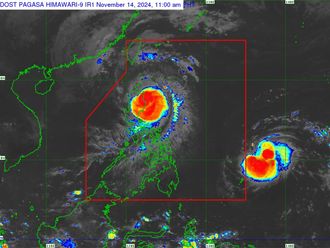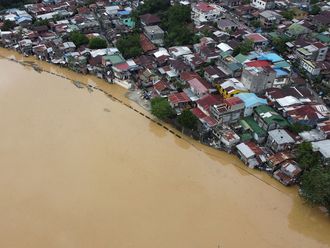
Manila: A strong tropical storm lashed the eastern part of central Philippines on Monday, threatening the disaster-prone nation’s east coast with giant waves, flooding and landslides, Civil Defence officials warned.
Up to 750,000 people had been evacuated to safer ground as gusts of up to 150kph made landfall in Samar province, dumping heavy rain that could cause flooding, landslides and storm surges, warned forecasters.
About 40 domestic flights were grounded, while 73 ferries and hundreds of fishing boats were ordered to remain in port as typhoon Melor hit the village of Batag on the northern tip of Samar island.
Known locally as typhoon "Nona", it was expected to roll across nearby islands. By Monday afternoon, Melor started lashing Sorsogon province, about 385 km (240 miles) southeast of the capital, Manila, on the heavily-populated main island of Luzon.
Melor was plotting a similar path to Haiyan, a category 5 typhoon that struck the central Philippines in 2013.
Almost 8,000 people were killed or left missing by Haiyan.
Disaster authorities have temporarily closed schools and some offices and evacuated about 750,000 people in three provinces. About 8,000 people were stranded after the coast guard stopped ferries and fishing boats from leaving ports in the central Philippines.
Dangers
“We should not underestimate the dangers posed by this storm,” Civil Defence chief Alexander Pama told a meeting of rescue officials.
Authorities ordered evacuations as Melor strengthened and gusting winds hit the impoverished farming island of Samar, home to 1.5 million people.
The storm was moving west-northwest over the Pacific Ocean Sunday.
Food packs and other emergency items were stockpiled in the areas forecast to be hammered by Melor and the military was put on standby to evacuate people if necessary.
Heavy rain, flooding and landslides were forecast in areas within 150km of its eye between Monday and Wednesday.
Melor is expected to cut across Samar, Masbate, Marinduque and Mindoro islands before heading out to the South China Sea near Manila early by Wednesday.
Storm surges, or giant crashing waves, were also a risk in some areas said Pama, executive director of the National Disaster Risk Reduction and Management Council.
A tropical storm becomes a typhoon when maximum sustained winds are stronger than 120kph, according to the state weather service.
The Philippines is battered by an average 20 typhoons or storms a year, many of them deadly.
Typhoon Koppu, the last deadly storm to hit the country, killed 54 people and forced tens of thousands of others to flee their homes in the northern Philippines in October.











